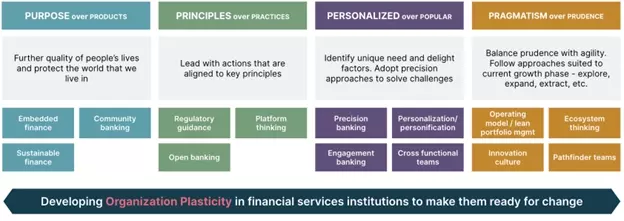While not a new concept, organizational plasticity is currently in the business spotlight. After the crises of the last few years – which are still in progress – companies are realizing their business framework needs to be more flexible to weather the next upheaval…. And the one after that.
Because challenging realities seem chronic in this day and age, many businesses are looking to organizational plasticity to help ensure they are ready for the uncertain future.
Why Storytelling is Key to Creating, Sustaining Organizational Plasticity
What is organizational plasticity?
The term “organizational plasticity” has yet to be formally defined, however, an article from 2021 explains plasticity as: “a combination of flexibility and adaptability that makes internal organizational processes malleable and open to change.”
There may not be a current formal definition – sometimes “organizational resilience”
can be used interchangeably. But there is a consensus that the concept of organizational plasticity evolved from “neuroplasticity,” which is the brain’s ability to evolve and adapt after challenges, or to rewire for growth.
Businesses that are implementing organizational plasticity are doing so because they realize they also need to rewire; to become more agile and resilient – and most ideally – recession-proof.
The success of organizational plasticity for any company depends on its workforce. Developing a workforce that will sustain organizational plasticity requires empathy, trust, and connection at a depth that is best created through storytelling.

Why is organizational plasticity necessary to sustain today’s business environment?
Organizational plasticity is a current Megatrend because businesses and their employees are still grappling with the emotional trauma of the past few years. I’m not just referring to COVID. We have been confronted with climate disasters, financial instability, social and political upheaval, global political instabilities, and warfare.
The human species has never quite lived through an era like this one.
The seismic shifts impacting humankind and business culture are not over. Change is constant and, in the digital age, is evolving ever more rapidly. Businesses will only thrive if they are malleable while their employees are nurtured to be agile and adaptable. This is why many businesses are adopting organizational plasticity as their new corporate framework.
A recent 2023 example, offered by Thoughtworks, discusses the use of organizational plasticity in the financial sector. “To develop organizational plasticity, especially through the downturn, incumbent financial institutions need to invest in product and distribution innovation, albeit judiciously…. The 4Ps model empowers financial services organizations to adapt and evolve based on the changes around them, making new (neural) connections and mimicking the brain’s neuroplasticity.”

What are the building blocks of organizational plasticity?
So, how can companies create and sustain organizational plasticity? First and foremost, it must adopt a growth mindset. More challenges are coming, and businesses need to be able to embrace those challenges as opportunities to learn, innovate, and collaborate.
Working from a growth mindset and sustaining organizational plasticity requires engaged, healthy employees. New HR technologies help track and quantify how employees are doing in the face of today’s challenges. They can assess the state of your organization’s progress in categories such as:
- Diversity and inclusion efforts
- Support systems for talent development and training programs
- Work-life balance support
- Scheduling flexibility
All of these are vital to organizational plasticity.
The strides that HR software has made are astounding. For example, the UKG Pay Equity Dashboard is helping to close the gender pay gap; and the Great Place To Work Hub, combines UKG research with employee data and input to build more inclusive and equitable environments.
Another crucial building block to sustaining organizational plasticity is a healthy culture anchored in diversity and inclusion. This is because diversity leads to greater innovation and productivity, while inclusion creates a strong and a psychologically safe work environment for employees.
HR technologies are evolving to better assess diversity and inclusion metrics, as well as directly engaging with employees to glean their insights about how companies are doing in these areas. These are invaluable tools.
Storytelling takes organizational plasticity one step further
There is a science to storytelling, which sets it apart from other modes of communication in terms of its efficacy. Why is that?
Because through sharing stories, our humanity is revealed, and empathy and connection are created. This is universal. It is why storytelling is at the center of so many successful business interactions.
Let's take diversity as an example of how storytelling is key to organizational plasticity. Diversity is an essential element; however, it does not always ensure a sense of belonging and inclusion – which are imperative. This is because inclusion and belonging require empathy, understanding, and connection. Sound familiar? Is it any wonder that storytelling is the bridge between these practices?
Another example of how storytelling can be necessary for supporting organizational plasticity is in driving innovation. There is no algorithm for innovation. The one constant we know is that naivete, curiosity, and a complexity (i.e., diversity) of thought partnership (which requires inclusivity) can foster innovation.
When these components -- or their corresponding employees -- are stalled, it is the connection that storytelling creates that can inspire collaboration and new ideas to get innovation back on track.
So, what kinds of stories should we be telling to bolster organizational plasticity? All kinds!
Tell stories about the shared trauma of the past few years. Funny stories about the foibles of life that cause us to cringe and are afraid to share – only to discover the relief that comes when we realize we aren’t alone.
The more stories, the more interaction, become the more opportunities to grow together. That growth fosters organizational plasticity.
Companies serve their goals best when creating safe spaces for storytelling in the workplace. You can make storytelling happen:
- In keynotes offered to employees
- In company-wide announcements
- In team and department meetings
- On internal company hubs
- In online company forums and discussion boards
- As direct interactions between employees, both in individual or group settings
The benefits of storytelling in the workplace are limitless. To quote Paul Zak, neuroeconomist: “The ability to… form relationships allows humans to engage in the kinds of large-scale cooperation that builds massive bridges and sends humans into space. By knowing someone’s story – where they came from, what they do – relationships… are formed.”
Storytelling is one of the most efficient and effective tools to create inroads and build better teams and companies. Companies that use storytelling will be better able to adapt to the uncertainties we are struggling through now and the unknown challenges on the horizon.
Why it’s important to have an employee-centered culture
Organizational plasticity is about building adaptable and resilient companies -- companies that are recession-proof and can weather any uncertainty. But having an employee-centered culture is key. If your workforce doesn’t feel safe, supported, and invested in, it will not commit to and invest its energy in the business. It will not strive for greater productivity and innovation.
Diversity – one of the cornerstones of organizational plasticity – helps in the short term, but it also needs support to reach its potential. It needs true inclusion and belonging to thrive.
In comes storytelling, which helps create inclusion and safe spaces in the workforce and supports the ascending levels of growth in culture development.
Storytelling is the key to creating and sustaining organizational plasticity now and for the future.



